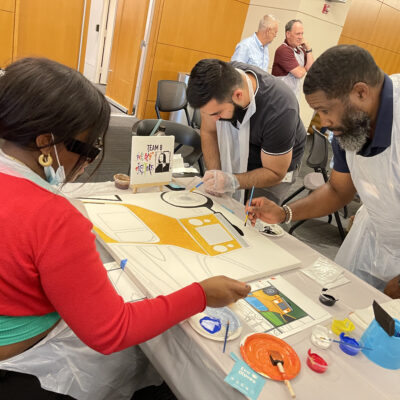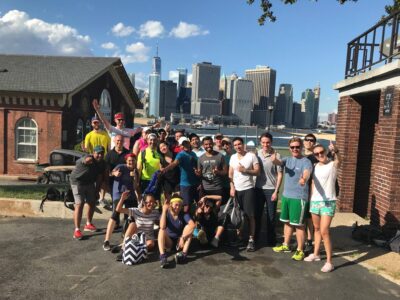Employees interact with their workplace and the people in it every day. They have experiences—good and bad—that create their perception and of their company and job. This is known as the employee experience, and it’s an incredibly important factor in business.
Just imagine the difference between an employee who has great interactions with their work, coworkers, and the tools they utilize and an employee who has negative interactions. It’s not hard to see how that could affect things like engagement, retention, performance, and more.
We talked about the importance of the employment experience during our podcast—PERKS of Employee Benefits—with the Founder of PERKSCon, Alexa Baggio, and the Director of Business Development, Saul Lookner. Baggio commented on the topic, saying:
You have to be able to support and create a lifestyle for your employees. And that is truly your differentiator as an employer… It’s become a test for how many services and what’s the right combination of services that actually creates the culture and the brand you are trying to instill.
No matter what kind of business you are in, the experience of your employees is essential to success. So keep reading to find out how you can improve the employee experience and drive your business forward towards your goals.
What is Employee Experience?
First things first—what is employee experience? In simple terms, it is the culmination of all the interactions and experiences an employee has at work. That includes the people, culture, technology, physical workspace, and anything else they interact with.
For example, an employee’s interactions with their boss or experience with platforms like Zoom or Google Teams are all part of their experience as employees. Even something as small as their office chair or desk lighting influences their experience.
That also applies to digital employees as well. The digital employee experience is just as important. Different things have more importance to remote employees, such as the technology utilized. However, they still interact with a multitude of things daily that inform their experience.
What’s the Importance of Employee Experience?
Now we know exactly what the employee workplace experience is, but why does it matter? What is the importance of the employee experience? Does an employee’s interaction with their office supplies or coworkers really matter that much?
The short answer—yes. The experience of employees impacts numerous aspects of business that are critical to success, such as retention, engagement, performance, innovation, culture, and more.
To illustrate, Gallup has been conducting an ongoing study of the employee workplace experience for over 20 years. The most recent study and analysis came up with some interesting results.
According to the study, business units in the top quartile of experience saw 23% higher profits than those in the bottom quartile. The study cites less absenteeism, higher retention, fewer safety incidents, fewer errors, and higher productivity as a driver for the difference in profit.
And intuitively, that all makes sense. Employees perform their best when they enjoy their workplace, have strong relationships with coworkers, and are engaged and motivated. They are more active and productive, making them better employees.
Key Pillars of an Employee Experience Strategy
Now that we’ve established why the experience of employees is important, the next step is figuring out an employee experience strategy. Coming up with a solid strategy can help you craft a better experience for employees, resulting in a more welcoming and productive workplace.
However, knowing how to improve the employee experience can be complicated. There are three key factors, all of which directly affect the experience of employees. Addressing all of these factors is essential in improving the experience of employees.
So let’s take a look at each of these factors, analyze how it affects the experience of employees, and find out ways to improve each factor to create a better experience for you and your employees.
People and Culture

The most obvious factor is the people and culture, also known as the people experience. Every interaction an employee has with their fellow employees impacts their experience, as does their interaction with company culture as a whole.
For example, say employees find themselves in cliques and silos. It may seem like a huge deal, but that can isolate employees and make them feel left out and alone. That creates a negative experience for the employees.
Now, say employees avoid silos and have a welcoming environment that embraces employees and their diversity. Those employees are going to feel included and be more likely to foster friendships, resulting in a positive experience for those employees.
There are lots of options for improving the experience in relation to people and the culture. Mentorship programs, employee development, improved onboarding, honest communication, recognition, and constructive feedback can help create a more positive workplace experience.
Ultimately, the goal is to foster positive interactions and relationships among employees while creating an open and welcoming workplace culture. If you focus on that, you’ll be sure to improve the experience of employees.
Work Technology
Another important factor in employee experience management is technology. Technology in the workplace plays an important role, especially in a post-COVID world where many people work remotely.
We all know how frustrating technology can be when it doesn’t want to cooperate. While some hiccups are an inevitability, faulty or incompatible technology can drag down the experience of employees over time.
That sort of thing is sadly very common in the workplace, and a regular negative experience with a piece of technology can really change how an employee views the workplace and their experience with it.
Thankfully, this is relatively easy to address. Get feedback on work tools/technology from the employees who use them. If there’s a better tool they want, get it. If they need more training, provide it.
The end goal is that your technology supports and enables workers to do the best work possible, not drag them down with tech problems or mismatches. So listen to your employees and help equip them with the tools and knowledge they need.
Physical Workplace
The last factor is the physical workplace itself. That includes everything from the furniture and lighting to snacks and managers peeking over shoulders. It also includes the physical workplace of remote workers, such as their home offices.
For example, an employee might have an office with non-ideal conditions. Maybe the temperature is too high, and the lighting is tiring on their eyes. That can quickly have an impact on their performance and productivity as they get distracted by the environment.
The way to deal with this is by creating a workplace where employees can be their most productive. A good start is by letting employees work where they’re most productive, at home or at the office.
You should also focus on improving the office space. Make it a pleasant space with things like music, snacks, comfy furniture, and climate control. Also make sure that managers aren’t constantly looking over employees’ shoulders, making them nervous.
At the end of the day, you want to make your office a place where employees feel comfortable and relaxed. That helps create a better experience for employees, resulting in higher productivity, efficiency, and output.

2025 Employee Experience Trends
Like many things in business, the employee experience is constantly changing. There are constantly new employees, technologies, and more that can potentially change the experience of employees.
If you want to stay ahead of the competition and continue producing a good experience for employees, you need to stay on top of employee experience trends. So let’s take a look at four trends for 2025 and see how they’ll impact the year to come.
AI Automation for Daily Tasks
If you’ve been paying attention at all the past few years, it should come as no surprise that the role of AI in the workplace will expand in 2025. That also means it will have an even bigger impact on the experience of employees than ever before.
For 2025, it seems like AI’s biggest role will be in automation of daily and tedious tasks. These are tasks that don’t really require much human input and discretion but take up lots of time, like entering data or sorting emails.
At TeamBonding, we already have plans to integrate AI into our daily tasks to save time. Our Controller, Nancy Fitzgerald, said:
“My work resolution for 2025 is to integrate more automation into the accounting department to save time for more tedious tasks.”
Whether you’re a fan of AI or not, it’s clear that it’s becoming an important tool in the workplace. Businesses that don’t adapt will fall behind, so it’s important to start incorporating AI and automation now and work it into the experience of employees.
Enhanced Work-Life Balance
Work-life balance has gotten increasingly important over the past few years, and 2025 will likely be no different. A healthy balance is something employees want. Businesses who support work-life balance will be rewarded for providing a better experience for employees.
Employees don’t want to feel like they spend their whole lives at work. It’s draining mentally and physically, resulting in lower productivity and a worse experience. But if businesses focus on that balance, they can help employees be as productive as possible by being happy and healthy.
At TeamBonding for example, we have a hybrid work model with many employees working remotely throughout the US. This helps employees get a better balance, saving time and money on commutes and allowing them to work more comfortably from home.
A key part of this is trust between employees and managers. Managers need to trust employees to get their work done and not micromanage, and employees need to trust that their managers will support them in having a healthy work-life balance.
Better Employee Well-being
Tying into work-life balance, employee wellbeing is another factor that is poised to be even more important in 2025 than in 2024. Employees want to be happy and healthy, and employers should want the same; happy and healthy employees are more engaged and more productive.
Employee well-being is a broad topic, so there are a lot of different ways to approach it. An emphasis on well-being programs is a great starting point. Our Employee Wellness Program is a great way to have fun, encourage bonds, and focus on employee well-being.
Other strategies include things like fitness stipends, gym access/memberships, nutrition classes/workshops, and similar programs. Incentives are another option, such as fitness contests for charity.
DEI Initiatives in Demand
Last on the list of trends for 2024, DEI initiatives are increasingly in demand. While there’s been a lot of discussion about DEI in the media, it’s clear that DEI is a benefit for both employees and their employers.
During our podcast episode—Diversity, Equity, and Inclusion in the Workplace—our guest, seasoned consultant Melanie Miller, made an interesting point about DEI in the workplace, saying:
“Everybody comes with their own experiences and cultural identities. Oftentimes, they come with the same cultural identity of someone who needs your product. It’s important to listen to these voices to understand your customers better as well.”
To further illustrate the importance of DEI, let’s look at a recent LinkedIn survey. The survey found that:
- Being in the top quartile for gender diversity resulted in a +25% chance of outperforming peers financially.
- Being in the top quartile for ethnic diversity resulted in a +36% chance of outperforming peers financially.
- 2.5x higher cash flow for diverse companies, per employee.
- 35% higher productivity in inclusive teams.
Those stats should make it clear that DEI initiatives are worth the effort. For 2025, businesses should emphasize their DEI initiatives to create a more diverse workforce that results in a more positive experience for employees.
Improve Your People Experience Expertise in 2025
The employee experience ties into everything employees interact with at work, and it can impact everything from engagement and retention to productivity and output. It’s become more important every year, and businesses need to focus on providing a positive experience for their employees.
Spending time with employees, listening to them, and getting feedback is the best way to improve the experience of employees. TeamBonding can help you facilitate workplace events to bond with employees and improve their experience in the workplace.
Don’t let your employee experience fall behind in 2025. Browse our selection of events and get in touch with us to start providing your employees with the experience they deserve.













